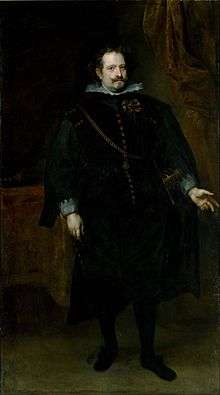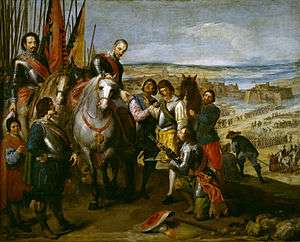Diego Felipez de Guzmán, 1st Marquis of Leganés

Diego Mexía Felipez de Guzmán y Dávila (1580–1655), Viscount of Butarque and first Marquis of Leganés, was a Spanish politician and army commander.
Biography
He was the youngest son of Diego Velázquez Dávila y Bracamonte, marquis of Loriana, and Leonor de Gúzman, aunt of the Count-Duke of Olivares.
Since 1600, he fought during more than 20 years in the Spanish Netherlands in the service of Albert VII, Archduke of Austria. After his death, Diego returned to Spain where his cousin Olivares had become valido, and under his patronage, Diego soon became very influential. He became a member of the State Council in 1626, was made Marquis of Leganés in 1627 and married in the same year with Polixena Spinola, the very rich daughter of the great general Ambrosio Spinola.
In 1627 he was sent back to Flanders to force the States General to accept Olivares' project of the Unión de Armas, and pay for an extra 12.000 infantry soldiers.
On his way back, he and general Ambrosio Spinola visited the Siege of La Rochelle by the French, on which occasion they discussed the succession of the Duchy of Mantua, which would eventually lead to the War of the Mantuan Succession.

After this mission, he held several important political and military posts in the Spanish Netherlands, which earned him the title of Grandee of Spain in 1634.
On September 24, 1635 he was named Captain General and Governor of the Duchy of Milan, and was soon involved in the Franco-Spanish War (1635) and the Piedmontese Civil War against France, Parma, Mantua and Savoy. He defeated Odoardo Farnese, Duke of Parma and Piacenza and forced him to sign a peace treaty in 1637. He also prevented the French to take the Valtellina and won some victories against Savoy.
In 1638 Leganés conquered Breme and Vercelli, and launched the next year a great offensive against Piedmont. He conquered a large number of cities, but suffered a great defeat near Casale and failed in the Siege of Turin (1640).
He was called back to Spain and in November 1641 given the command of the army of Catalonia to push back the French and Catalan troops in the Catalan Revolt.
After some initial successes in defending Tarragona, he suffered a defeat in the Battle of Lerida (1642), which made him fall from grace.
In 1645 he was rehabilitated and made nominal Viceroy of Catalonia where he defended successfully the city of Lérida in 1646. He remained viceroy until 1648.
He spent the last years of his life in Italy as president of the council of Italy.
Marriage and children
- First he married Polixena Spinola (died 1639), daughter of Ambrosio Spinola. They had two children :
- Gaspar Felípez de Guzmán y Spinola, second marquis of Leganés, Viceroy of Valencia and governor of Oran.
- Ambrosio Ignacio Mexía Felípez de Guzmán y Spinola (1632–1684), tutor of Balthasar Charles, Prince of Asturias and Archbishop.
- He next married Juana Fernández de Córdoba y Rojas, daughter of Luis Fernández de Córdoba, 6th Duke of Sessa.
Art collector
The marquis of Leganés was also one of the greatest art collectors of his time, he is said to have owned a total of 1.330 paintings. He was also painted by Anthony van Dyck, a painting which today can be found in the Banco Santander Foundation in Madrid.
Bibliography
- El conde duque de Olivares, John Elliott.
- En estado de guerra. Felipe IV y Flandes, 1629-1648; René Vermeir.
- Milán español, Gianvittorio Signorotto.
Further reading
- Liedtke , Walter A. (1984). Flemish paintings in the Metropolitan Museum of Art. New York: The Metropolitan Museum of Art. ISBN 0870993569. (see index, v.1, for information about his art collecting).
External links
| Wikimedia Commons has media related to Diego Felipe de Guzmán. |
- Retrato de Diego Felipez de Guzmán, Marquis of Leganés, his biography in Spanish from 1791.
| Preceded by Cardinal Gil de Albornoz |
Governor of the Duchy of Milan 1635–1636 |
Succeeded by Fernando Afán de Ribera, duke of Alcalá de los Gazules |
| Preceded by Fernando Afán de Ribera, duke of Alcalá de los Gazules |
Governor of the Duchy of Milan 1636–1641 |
Succeeded by Juan de Velasco, Count of Siruela |